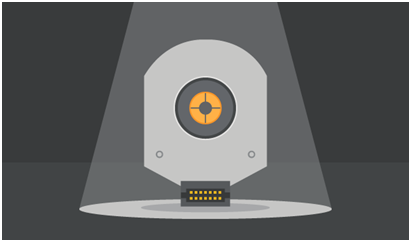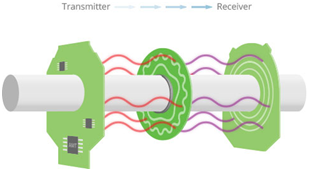
 Incremental modular capacitive encoders
offer the rugged durability of a
magnetic encoder
Incremental modular capacitive encoders
offer the rugged durability of a
magnetic encoder
 alongside the precision and accuracy of an
optical encoder
in one compact package. This guide will detail the various
alongside the precision and accuracy of an
optical encoder
in one compact package. This guide will detail the various features of these reliable, versatile, and easy-to-use devices.
What is a capacitive encoder? How do capacitive encoders work?
A capacitive encoder is a specific type of encoder which implements technology similar to that used in digital calipers to identify changes in capacitance using a high-frequency signal to measure rotary motion. The digital output provides information regarding positioning, direction, and velocity.

Components of a capacitive encoder: a stationary AC field transmitter emits a current which is modulated by the sinusoidal pattern stamped on the rotating rotor. The stationary receiver converts the modulated signal into output pulses. (Image Source: CUI, Inc.)
Why choose a capacitive encoder?
Optical encoders are known for their precision, however they are more susceptible to environmental factors. Magnetic encoders are designed with robustness in mind, with protections against environmental factors, but are unable to provide resolutions and accuracy to compete with optical encoders. Capacitive encoders combine the accuracy of optical encoders with the durability of magnetic encoders, ensuring you get the best of both worlds. Ruggedly designed,
AMT10,
AMT11S, and
AMT11Q
series encoders are protected against the ingress of dust, dirt, and oils and include no optical disks. The low current requirements of capacitive encoders are yet another benefit. On average, AMT encoders draw less than one-tenth of the current comparable optical encoders require (3.6-5.5 VDC), allowing for more freedom in battery powered and mobile applications.
Additionally, with no LEDs included in the design, there is no concern about possible LED failure as with other encoder types. These units are able to operate at within a wider range of temperatures (from -40°C up to 125 °C), are less susceptible to vibration and environmental contaminants, and draw significantly less energy than comparable magnetic or optical models. With nine shaft options, four mounting options, and sixteen programmable resolution options, Anaheim Automation's line of capacitive encoders offer unmatched adaptability to suit a wide range of applications. Capacitive encoders conveniently allow for the user to adjust resolution without needing to change components. And, because AMT capacitive encoders do not include optical discs, they are able to offer a smaller, sleeker profile. This enables them to be used in tighter spaces where optical or magnetic encoders may be unable to fit. Their small size also reduces potential motor backlash.
| Series | Length (mm) | Width (mm) | Height (mm) | Operating Temperature | Input Voltage (VDC) | Maximum Speed (RPM) |
Shaft Options | Resolution |
|---|---|---|---|---|---|---|---|---|
| A5SI | 51.82 | 16.59 | 16.59 | -40 - 100°C (model dependent) |
4.5 - 5.5 | 8640 | 2mm - 10mm (model dependent) |
500 - 5000 CPR (model dependent) |
| M15I | 52 | 46 | 17 | -40 - 125°C (model dependent) |
4.5 - 5.5 | 10000 | 0.125" - 0.500" (model dependent) |
100 - 2048 CPR (model dependent) |
| AMT10 | 34.20 - 43.39 (model dependent) | 28.60 - 28.77 (model dependent) | 9.00 | -40 - 100°C | 3.6 - 5.5 | 7500 | Kit with 9 Bore Sleeve Options (.079 - .315") | 16 DIP Selectable Resolutions (48 - 2048 PPR) |
| AMT11 | 37.25 - 37.39 (model dependent) | 28.58 | 10.34 | -40 - 125°C | 4.5 - 5.5 | 8000 | Kit with 9 Bore Sleeve Options (.079 - .315") | ***Selectable Incremental Resolutions up to 4096 PPR |
What types of applications are capacitive encoders suitable for?
Capacitive encoders can be used in a wide variety of industries and applications. Essentially, anywhere one might use an optical or magnetic encoder for motion feedback, a capacitive encoder can be used instead. Whether it be an industrial, automation, robotics, or renewable energy application, incremental modular capacitive encoders are the superior solution. ( AMT10, AMT11S, and AMT11Q series encoders may not be suitable for explosion-proof projects.)
How are AMT capacitive encoders assembled?
AMT capacitive encoder kits are easy to assemble; it takes just a few seconds. First, select the proper shaft sleeve for your requirements. Next, snap the shaft adapter onto the selected sleeve on the rear shaft of a dual-shafted DC motor. Aligning your preferred mounting hole option, mount your chosen base to the shaft and snap the top cover in place. AMT encoders are ideal for mounting directly to nearly any model of motor.
Frequently Asked Questions
- Are the AMT10 and AMT11 series incremental, absolute, or commutation encoders?
AMT10 and AMT11 encoders are high-accuracy incremental modular encoders.
- What is the life-expectancy of AMT encoders?
Rotational lifetime is theoretically infinite, as these encoders do not utilize components which will wear out.
- How protected are AMT encoders against environmental factors?
Because AMT encoders do not utilize optical disks, contaminants such as dust or dirt, or interference from vibration or shock, are not a concern. So long as the rotor is able to rotate without obstruction, the electromagnetic field will be transmitted and received - non-conductive particles will have no effect. AMT encoders can also be safely submerged in non-conductive fluids like oil without effecting their operation.
- Is it possible to mount an AMT encoder without using screws?
If you are using an AMT encoder in a location where drilling is not possible, you may use a glue, epoxy, or other adhesive recommended for use with plastic. Adhesive tapes are not suitable for mounting an AMT encoder.
- How can I select my final resolution?
AMT10 series encoders are equipped with a 4-position DIP switch on the rear side. Users can select from 16 different resolution options using the switch. AMT11 series encoders are programmed using an appropriate cable and a PC equipped with CUI's AMT Viewpoint software.
- I have questions that are not answered in this guide. Where can I find more information?
Additional information, spec sheets, and dimensions can be located on the AMT10, AMT11S, and AMT11Q series pages. For further assistance, please contact our applications engineers.
.PNG)
